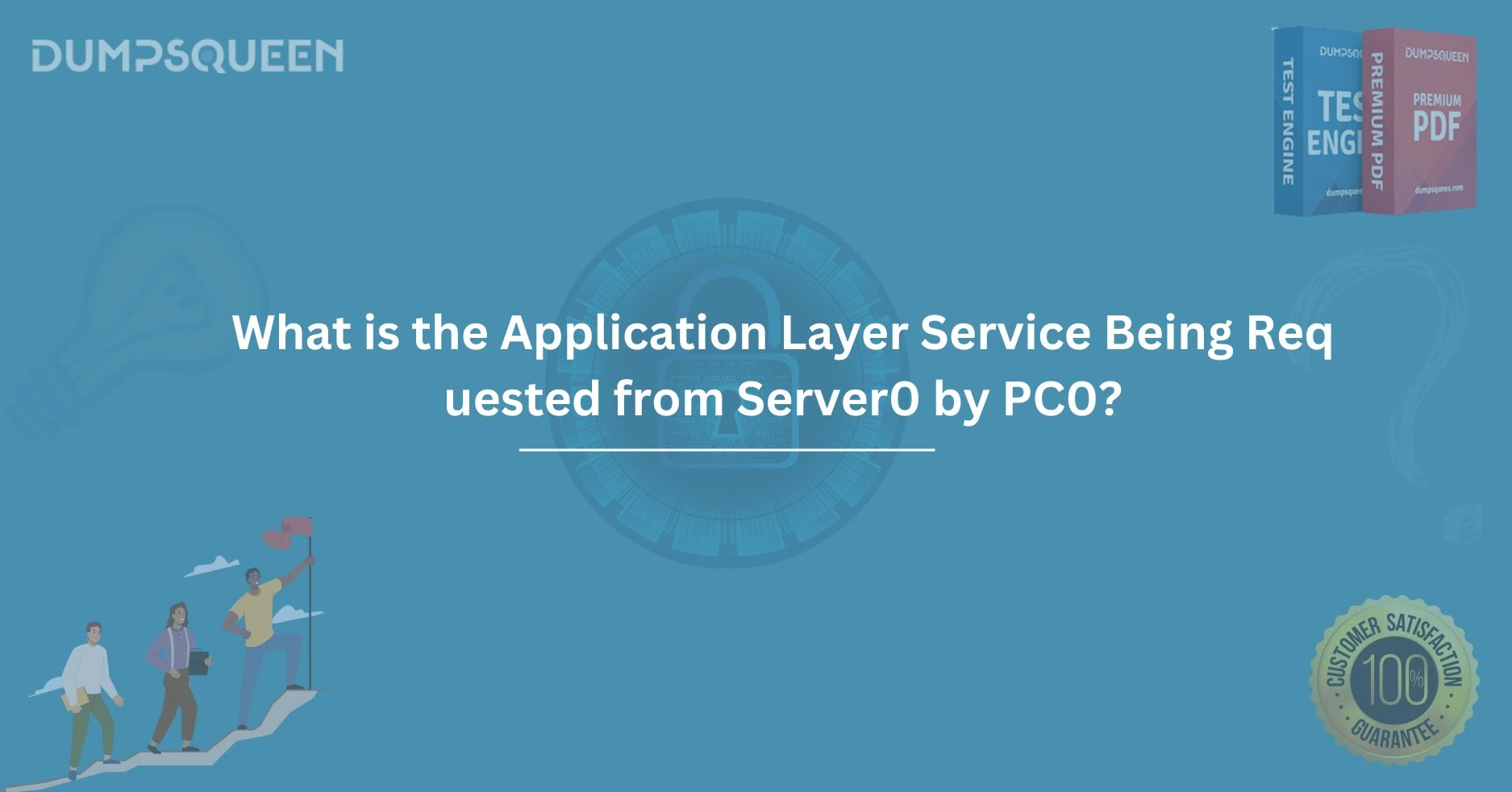Introduction
In the realm of computer networking, the interaction between devices like PC0 and Server0 is a cornerstone of modern communication systems. At the heart of these interactions lies the application layer, the topmost layer of the OSI (Open Systems Interconnection) model, which facilitates direct communication between users and network services. When PC0 requests a service from Server0, it engages with the application layer protocols to access specific functionalities, such as web browsing, email services, or file transfers. Understanding the nature of the application layer service being requested is critical for network administrators, IT professionals, and students preparing for certification exams. This blog, brought to you by DumpsQueen, the official website for top-tier IT certification resources, delves into the intricacies of what it means when PC0 requests an application layer service from Server0, exploring protocols, processes, and practical implications in detail.
The Role of the Application Layer in Networking
The application layer serves as the interface between the end user and the network. It enables software applications to communicate over a network by providing protocols and services that applications rely on to function. When PC0, a client device such as a personal computer, initiates a request to Server0, a server hosting network resources, it does so through the application layer. This layer is responsible for ensuring that the communication is meaningful and that the requested service is delivered effectively.
For instance, if a user on PC0 opens a web browser to access a webpage hosted on Server0, the application layer protocol involved is HTTP (Hypertext Transfer Protocol) or its secure variant, HTTPS. The application layer translates the user’s action—typing a URL—into a request that Server0 can understand and respond to. Similarly, other services like email (using SMTP, IMAP, or POP3) or file transfers (using FTP) also rely on application layer protocols to facilitate communication.
DumpsQueen emphasizes the importance of understanding these protocols for professionals pursuing certifications like CompTIA Network+, CCNA, or other networking credentials. By mastering the application layer’s role, candidates can better troubleshoot network issues and design efficient systems.
How PC0 Initiates a Request to Server0
When PC0 requests a service from Server0, the process begins with an application on PC0 generating a request. This request is formatted according to the specific application layer protocol associated with the service. For example, if PC0 is accessing a website, the browser sends an HTTP GET request to Server0, specifying the desired resource, such as an HTML page or an image.
The request is encapsulated into packets, which travel down the OSI layers on PC0—from the application layer to the transport layer (where TCP or UDP headers are added), then to the network layer (where IP addresses are included), and finally to the data link and physical layers for transmission over the network. Upon reaching Server0, the packets are decapsulated in reverse order, with the application layer on Server0 interpreting the request and generating an appropriate response.
This process highlights the seamless collaboration between layers, but the application layer’s role is unique because it directly handles the user’s intent. Whether PC0 is requesting a webpage, sending an email, or streaming a video, the application layer ensures that the correct service is invoked on Server0.
Common Application Layer Protocols Involved
Several protocols operate at the application layer, each designed for specific types of services. Understanding which protocol is in use when PC0 communicates with Server0 is key to identifying the application layer service being requested. Here are some of the most common protocols:
- HTTP/HTTPS: Used for web browsing, these protocols allow PC0 to request webpages, images, or other resources from Server0. HTTPS adds a layer of encryption for secure communication, critical for online transactions.
- SMTP, IMAP, POP3: These protocols govern email services. If PC0 is sending an email, it uses SMTP to communicate with Server0. For retrieving emails, IMAP or POP3 is used, depending on whether the user wants to manage emails on the server or download them locally.
- FTP/SFTP: For file transfers, PC0 may use FTP to upload or download files from Server0. SFTP, a secure version, encrypts the data to protect sensitive information.
- DNS: When PC0 needs to resolve a domain name (e.g., www.example.com) to an IP address, it sends a DNS query to Server0, which may act as a DNS server or forward the request.
- Telnet/SSH: For remote access, PC0 might use Telnet or SSH to connect to Server0, allowing the user to execute commands or manage the server remotely.
Each protocol defines how PC0 structures its request and how Server0 responds, ensuring standardized communication. DumpsQueen comprehensive study materials cover these protocols in depth, helping candidates grasp their nuances for certification success.
Scenarios of Application Layer Services in Action
To illustrate how PC0 requests services from Server0, let’s explore a few practical scenarios:
- Web Browsing: A user on PC0 enters www.dumpsqueen.com into a browser. The browser sends an HTTP or HTTPS request to Server0, which hosts the DumpsQueen website. Server0 responds with the requested webpage, which the browser renders for the user. This interaction relies on the HTTP/HTTPS protocol at the application layer.
- Email Communication: If PC0 is configured with an email client, it may send an email using SMTP to Server0, which acts as an email server. Alternatively, PC0 might retrieve emails from Server0 using IMAP, allowing the user to view messages without downloading them permanently.
- File Sharing: In a corporate environment, PC0 might use FTP to download a large dataset from Server0. If security is a concern, SFTP ensures that the file transfer is encrypted, protecting sensitive data from interception.
- Domain Name Resolution: When PC0 needs to access a website, it first sends a DNS query to Server0 (if configured as a DNS server) to obtain the IP address of the target domain. This DNS service is critical for translating human-readable domain names into machine-readable IP addresses.
These scenarios demonstrate the versatility of application layer services and their importance in everyday networking tasks. By studying with DumpsQueen, aspiring IT professionals can gain hands-on knowledge of these scenarios through practice exams and simulations.
The Importance of Ports in Application Layer Communication
Application layer protocols rely on transport layer protocols like TCP or UDP to carry data across the network. Each application layer service is associated with a specific port number, which helps Server0 identify the type of service PC0 is requesting. For example:
- HTTP uses port 80, while HTTPS uses port 443.
- SMTP operates on port 25, IMAP on port 143, and POP3 on port 110.
- FTP uses ports 20 and 21, while SFTP typically uses port 22 (shared with SSH).
- DNS queries are sent to port 53.
When PC0 sends a request to Server0, it includes the destination port number in the packet header. Server0 uses this port to direct the request to the correct application or service running on the server. For instance, a packet destined for port 80 tells Server0 that PC0 is requesting a web service via HTTP.
Understanding port numbers is crucial for troubleshooting and securing networks. Misconfigured ports or open ports can lead to vulnerabilities, which is why DumpsQueen resources emphasize port management for certification candidates.
Security Considerations for Application Layer Services
As PC0 communicates with Server0, security becomes a paramount concern. Application layer services are often targeted by cybercriminals because they are directly accessible to users. Common threats include:
- Man-in-the-Middle Attacks: If PC0 uses HTTP instead of HTTPS, attackers could intercept data exchanged with Server0, compromising sensitive information.
- Phishing via Email: Malicious emails sent through SMTP could trick users on PC0 into revealing credentials or downloading malware.
- Unauthorized Access: Weak configurations in FTP or Telnet services on Server0 could allow attackers to gain access, highlighting the need for secure alternatives like SFTP or SSH.
To mitigate these risks, Server0 should implement encryption (e.g., TLS/SSL for HTTPS), strong authentication mechanisms, and regular updates to application layer software. PC0, on the other hand, should use secure clients and keep applications patched.
DumpsQueen study guides for certifications like CompTIA Security+ and CISSP provide detailed insights into securing application layer services, equipping professionals to protect networks effectively.
Troubleshooting Application Layer Issues
When PC0 fails to receive the expected service from Server0, the issue may originate at the application layer. Common problems include:
- Protocol Mismatch: If PC0 sends an HTTP request to a server expecting HTTPS, the connection will fail. Ensuring the correct protocol and port is critical.
- Server Misconfiguration: Server0 might not have the requested service (e.g., a web server) installed or running, leading to errors like “404 Not Found” or “Service Unavailable.”
- Firewall Blocking: Firewalls on PC0 or Server0 may block specific ports, preventing communication. For example, a firewall blocking port 25 would disrupt SMTP traffic.
- DNS Issues: If PC0 cannot resolve Server0’s domain name due to a faulty DNS query, the connection attempt will fail.
Troubleshooting requires tools like packet analyzers (e.g., Wireshark) to inspect application layer traffic, as well as knowledge of protocol behavior. DumpsQueen practice exams simulate these scenarios, helping candidates develop the skills needed to diagnose and resolve issues.
Conclusion
The application layer is the gateway through which PC0 interacts with Server0, enabling a wide range of services from web browsing to email communication and file transfers. By understanding the protocols, ports, and security considerations involved, IT professionals can ensure seamless and secure network operations. Whether you’re troubleshooting a failed connection or designing a robust network, mastery of application layer services is essential. DumpsQueen for IT certification resources, empowers candidates with the knowledge and tools needed to excel in networking certifications.
Free Sample Questions
- Which protocol is used when PC0 requests a webpage from Server0?
a) FTP
b) SMTP
c) HTTP
d) DNS
Answer: c) HTTP - What port does Server0 use to respond to a DNS query from PC0?
a) 80
b) 53
c) 25
d) 443
Answer: b) 53 - If PC0 uses IMAP to access emails on Server0, what is the primary function of this protocol?
a) Sending emails
b) Managing emails on the server
c) Downloading emails permanently
d) Resolving domain names
Answer: b) Managing emails on the server - Which secure protocol should PC0 use to transfer files to Server0?
a) FTP
b) Telnet
c) SFTP
d) HTTP
Answer: c) SFTP



